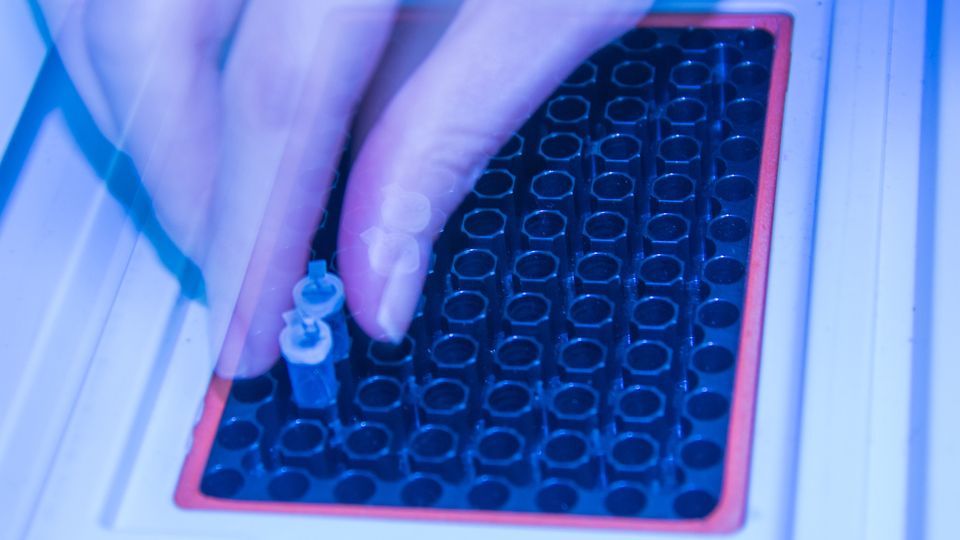Top Tips for Consistent qPCR
How To Guide
Published: September 11, 2023
|
Aditi Verma, PhD
Aditi Verma holds a PhD in neuroscience from the Indian Institute of Science, Bangalore, India. Her research has involved using molecular, cell and computational biology tools and techniques to understand the pathological mechanisms underlying neurological disorders.
Learn about our editorial policies

Credit: iStock
Quantitative real-time PCR (qPCR) has become a staple of molecular biology laboratories worldwide, with a broad range of applications including gene expression analysis, single nucleotide polymorphism genotyping, pathogen detection, drug discovery and clinical diagnosis.
Careful experimental design with appropriate positive and negative controls is extremely important to obtain reliable results in a qPCR experiment.
Download this guide to learn more about:
- Designing qPCR experiments
- Endogenous, negative and positive controls
- Data analysis and ensuring good data quality
How to Guide
1
Top Tips for Consistent qPCR
Aditi Verma, PhD
Quantitative real-time PCR (qPCR) has become a staple of molecular biology laboratories worldwide,
with a broad range of applications including gene expression analysis, single nucleotide polymorphism
(SNP) genotyping, pathogen detection, copy number variation (CNV) analysis, drug discovery and clinical
diagnosis.1
qPCR offers several advantages including, a high dynamic range, high sensitivity, reproducibility and the ability to study multiple samples and genes simultaneously through multiplexing.2
The
technique uses a fluorescent probe or dye to enable the detection of the amplification products, allowing
them to be quantified in real time. Determining the amplification cycle at which the fluorescence reaches
a certain threshold of detection (Ct value) can provide an estimate of the relative abundance of the starting material, while the inclusion of standards of known copy number can enable absolute quantitation.
Careful experimental design with appropriate positive and negative controls is extremely important to
obtain reliable results in a qPCR experiment. Furthermore, given the sensitivity of qPCR, maintaining good
laboratory technique is essential for reproducible results, which applies at all stages of the process from
experimental design and sample preparation to data analysis.
Let’s look at some of the key considerations for achieving consistent qPCR results.
1. Designing the experiment
Before you begin an experiment, it is useful to have a plan of what the experiment requires laid out
clearly. This includes the total number of samples to be analyzed, the number of genes to be investigated
and the exact comparisons that are to be made. For example, if your experiment involves comparing the
transcription of multiple genes after administration of a drug to a cell line, you need to design the experiment so that you have enough (typically three to five) biological replicates of the drug treatment with an
equal number of replicates for control (vehicle-treated cells). For each sample and each gene, multiple
technical replicates need to be set up too. In addition, you need to include positive, negative and no template controls (NTCs). Calculate the total number of reactions based on all these parameters and choose a
suitably sized multi-well plate or set of reaction strips that is/are compatible with your instrument.
As an example, if you are investigating 2 genes (1 gene of interest and 1 normalization control) in a total
of 8 samples (4 tests and 4 controls) with 3 technical replicates for each reaction, you would have a total
of 48 reactions. In addition, you would run NTCs and negative controls for each gene primer set in triplicate, which will add another 12 reactions. You will also need to include positive controls, which may for
some experiments be in the form of a standard curve. For standard curves, up to five dilutions for each
primer set are typically included using a sample known to be positive for the target. If using complementary DNA (cDNA), ensure the positive control transcribes the target gene at robust and consistent levels.
The standard curve, when run in triplicate, will add another 30 reactions. Thus, you will have a total of 90
reactions and choose a 96-well plate for the experiment.
TOP TIPS FOR CONSISTENT QPCR 2
How to Guide
It is helpful to have the multi-well plate layout printed on a sheet that can be filled prior to starting the
experiment so that you know exactly where the samples, reaction mixes with primers and controls go on
the plate. This comes in handy when you are loading the plate manually and helps to avoid mistakes.
2. Pipetting technique
Good pipetting technique is crucial for successful qPCR experiments. This is because the reaction volumes are quite small and the sensitivity of the technique is high, meaning small errors or carryover can
have a big impact on results. Quantification of the genetic material hinges on the extent of detection of the
PCR amplicons via the fluorescent probe or dye. Thus, if the amount of the starting material is not consistent, the results will be skewed in favor of the samples for which more starting material was added and
the comparison will not be accurate. Even a fraction of a microliter of extra starting material can skew
the results, and therefore careful pipetting is very important. Although the normalization controls help
to ensure that errors due to erroneous pipetting do not creep in, it is good practice to set at least two or
preferably three technical replicates for each reaction to highlight inconsistencies.
To help minimize pipetting errors, pipettes should be calibrated regularly, kept clean and well-maintained. Pipetting technique needs to be practiced, ensuring precise volumes are dispensed and remain
consistent across multiple wells. Slow and careful pipetting while keeping a visual check on the volumes aspirated and dispensed is good practice. Further, ensuring that excess samples or reagents do
not stick to the outside of the pipette tip, making sure that the pipette tip touches the walls of the well
while dispensing and avoiding bubbles are some other points to remember. Using filtered pipette tips
can help to reduce the introduction of contaminants. Additionally, it is important to ensure reagents are
mixed thoroughly.
3. Endogenous (normalization), negative and positive controls
There are several types of controls used in a qPCR experiment. Genes that are constitutively transcribed in the sample of interest can serve as endogenous or normalization controls when performing
gene transcription studies using cDNA as the template. For genomic DNA (gDNA), a gene that is stable
in the genome and unlikely to be lost, such as a housekeeping gene, can be used. The idea behind using
these reference genes as normalization controls is that their copy number is expected to be similar
across samples and, hence, variation in these genes would reflect differences in sample loading. Normalizing for these reference genes can, thus, provide a more accurate result. Normalizing controls are
indispensable for gene transcriptional studies and often multiple reference genes are used in the same
experiment to improve rigor.
3
Negative controls and NTCs should be included in the qPCR experiment to rule out contamination in the
master mix (NTC) or cross-reactivity in the sample (negative control). Both should result in the absence
of a detectable signal for the target gene but, in the case of the negative control only, should still show
amplification in the normalization control (if included).
Further, positive controls, such as samples in which the genes are known to be present in the case of
gDNA or transcribed at robust levels in the case of cDNA, can help verify that the components of the
reaction mix are working. Appropriate controls thus help to ensure that the results obtained are accurate by ruling out false positives, false negatives and, in the case of normalization controls, they help to
counteract the effects of sample quantity variations.
TOP TIPS FOR CONSISTENT QPCR 3
How to Guide
4. Sample preparation
The quality and quantity of the DNA that serves as the starting material for qPCR is important for the
success of an experiment. It is a good idea to calculate overall how much sample will be required for
the experiment as discussed in the section on experimental design. This helps to estimate the amount
of starting material, such as tissue or cell culture volumes, that is required. This can also help to decide
which method of RNA/DNA extraction will yield an appropriate amount of sample. High quality DNA samples are paramount for successful experiments. Spectrophotometric absorbance readings of RNA and
DNA can provide a good estimate of the quality. Further, the integrity value for RNA can be used to decide
if the RNA can be used to synthesize cDNA for the qPCR assay.
The final concentration of the cDNA/DNA that will be used for the qPCR should be estimated using a
spectrophotometric method and an optimum quantity of the sample used for the experiment. Too high
or too low a sample concentration will lead to Ct (threshold cycle) values that do not fall in the dynamic
range of the instrument and are not reliable.
5. Primer design and standardization
Primer design and standardization is crucial to a successful qPCR and great care needs to be taken to
ensure that the primers are highly specific and suit the experimental design.4
Several online tools are
available to aid with qPCR primer design. You should consider the primer length, annealing temperature,
GC content, primer specificity and check for primer dimer formation.
A primer length of 18–20 nucleotides is optimal for qPCR primers. Annealing temperatures typically
range from 55–60 0
C . If you plan to run multiplex qPCRs or many different single primer reactions on
the same plate, the primer annealing temperatures need to match. Aim for a GC content around 40–60%.
To check for primer specificity, you will need to perform in silico oligonucleotide alignment checks – for
which there are a variety of free online tools – with all the existing RNA/DNA in the species and ensure
that the designed primers anneal specifically to the target and to no other sequence of nucleotides.
Further, it is good practice to check if the forward and reverse primers have a tendency to anneal to each
other and form primer dimers.
The designed primer pairs also need to be checked by running small-scale PCR reactions and checking
the amplified products by gel electrophoresis to ensure that the primers work, and the PCR reactions
result in a single amplicon of the desired size. Additionally, when running the qPCR experiment using
DNA intercalating dyes, it is useful to perform melt curve analysis as additional non-specific or off-target
products can be identified if present. If performing multiplex qPCR, the qPCR can be run simultaneously in
a singleplex and multiplex manner with a small subset of the samples to make sure that the amplification
curves match in both cases.
As discussed previously, it is important to include the appropriate controls to ensure the primers are
working as expected.
6. Reagent quality
Positive, negative and NTC controls included in the qPCR experiment will enable you to know if one or
more reagents are not working properly; however, you would still not know which reagent is not working.
It is therefore best to proactively ensure that the reagents and samples are stored at appropriate temperatures and are of optimum quality. Master mixes whose expiry dates have passed are best avoided.
TOP TIPS FOR CONSISTENT QPCR 4
How to Guide
Primers, master mixes and samples can be stored as aliquots to prevent contamination of your whole
stock and degradation due to temperature fluctuations from repeated freeze–thaw cycles. When starting
to use a master mix from a new source or a new batch, it is a good idea to perform a small-scale experiment with controls to ensure that it works as expected.
Moreover, you need to choose the master mix with the appropriate qPCR probes/dyes carefully based on
the experimental design as there are many different types available, including but not limited to SYBR
Green, TaqMan probes, molecular beacons, Eclipse probes, dual hybridization probes and Amplifluor
assays. While SYBR Green chemistry is generally used for singleplex qPCR, TaqMan assays are often
preferred for multiplex qPCR.
7. Loading the qPCR plate
If loading the qPCR manually, caution needs to be exercised in handling a large number of reactions.
Common mistakes that happen include loading the samples in the wrong wells, contaminating reactions
with unintended samples or master mix and not mixing samples and reagents properly before starting
the qPCR reaction.
A qPCR experiment would typically have many of these reactions and it can get confusing to know which
sample or primer mix goes in which well. Having a printed and filled plate layout comes in handy to avoid
confusion in loading the plate. Moreover, it is important to stay focused and avoid distractions if loading
the plate manually.
To avoid cross-contamination, change pipette tips when going from one sample to another or from one
primer reagent mix to the next.
Ensure the plate is sealed with an optical adhesive film that is compatible with your instrument to prevent
cross contamination and evaporation of the reaction mix during the qPCR. Further, you need to ensure that
the reaction components have moved to the bottom of the well and are not sticking to the walls. It is a good
idea to spin the plate at a low speed, e.g., 300 x g for about five minutes, after covering the plate with film.
8. Data analysis and ensuring good data quality
Once the qPCR run is complete, it is a good idea to check the amplification curves to ensure that the
threshold cycle has been selected accurately by the software and the Ct values are reliable for all the replicates. It is also important to check the melt curves, if using an intercalating dye such as SYBR Green, to
determine if there was only a single type of amplification product. When analyzing the data, an average of
the values of technical replicates is taken to make the data robust. There are several factors that you can
investigate to make sure that the data that has been obtained is reliable. The first thing to check would
be the controls and standard curves to see if the amplification has followed the logarithmic pattern as
expected and there has been no spurious amplification. The Ct values should ideally lie within the range
of 20–30. Ct values that are too low indicate saturation of the signal, where too high a concentration of
sample has been used, for example. Ct values that are too high would indicate a lack of amplification. This
may occur for a number of reasons, including if sample concentrations are too low, there is a problem
with the reaction mix or there is a contaminating inhibitor present. This may also be seen when primer
dimer formation occurs, appearing late in the reaction when there has been no true amplification of the
desired product. It is important to check if the Ct values for the replicates (technical and biological) match.
Too much variation among the technical replicates means that your qPCR results are unreliable and variation between biological replicates may indicate issues in the experimental treatments you are testing.
TOP TIPS FOR CONSISTENT QPCR 5
How to Guide
Once you are happy your data is reliable and robust, the next step is analysis. The commonly employed
method of data analysis of differential gene transcription is the ΔΔCt method.5
This method involves the
normalization of the data using the endogenous controls and then comparison with the experimental
controls to give a relative gene transcription value. Alternative methods, such as presence/absence calling, can be employed depending on the experimental question being asked, qPCR method employed and
material being analyzed.
In conclusion, qPCR is a powerful technique, which has a variety of uses in research and diagnosis. However, being a sensitive technique, it is often fraught with inconsistent results. A careful approach incorporating the suggestions presented in this guide can help yield reproducible and reliable results.
Sponsored by:
References
1. Klein D. Quantification using real-time PCR technology: applications and limitations. Trends Mol Med. 2002;8(6):257–260.
doi: 10.1016/S1471-4914(02)02355-9
2. Smith CJ, Osborn AM. Advantages and limitations of quantitative PCR (Q-PCR)-based approaches in microbial ecology.
FEMS Microbiol Ecol. 2009;67(1):6–20. doi: 10.1111/j.1574-6941.2008.00629.x
3. Chapman JR, Waldenström J. With reference to reference genes: A systematic review of endogenous controls in gene
expression studies. PLoS One. 2015;10(11):e0141853. doi: 10.1371/journal.pone.0141853
4. Bustin S, Huggett J. qPCR primer design revisited. Biomol Detect Quantif. 2017;14:19–28. doi:10.1016/j.bdq.2017.11.001
5. Livak KJ, Schmittgen TD. Analysis of relative gene expression data using real-time quantitative PCR and the 2(-Delta
Delta C(T)) Method. Methods. 2001;25(4):402–408. doi: 10.1006/meth.2001.1262
Sponsored by

Download the How To Guide for FREE Now!
Information you provide will be shared with the sponsors for this content. Technology Networks or its sponsors may contact you to offer you content or products based on your interest in this topic. You may opt-out at any time.


